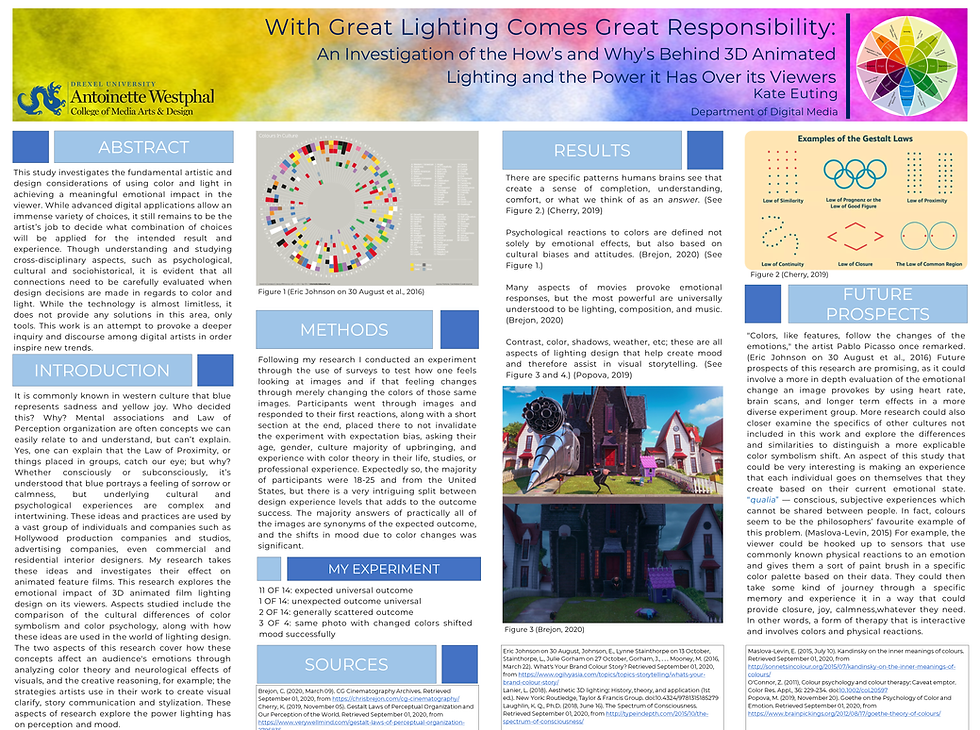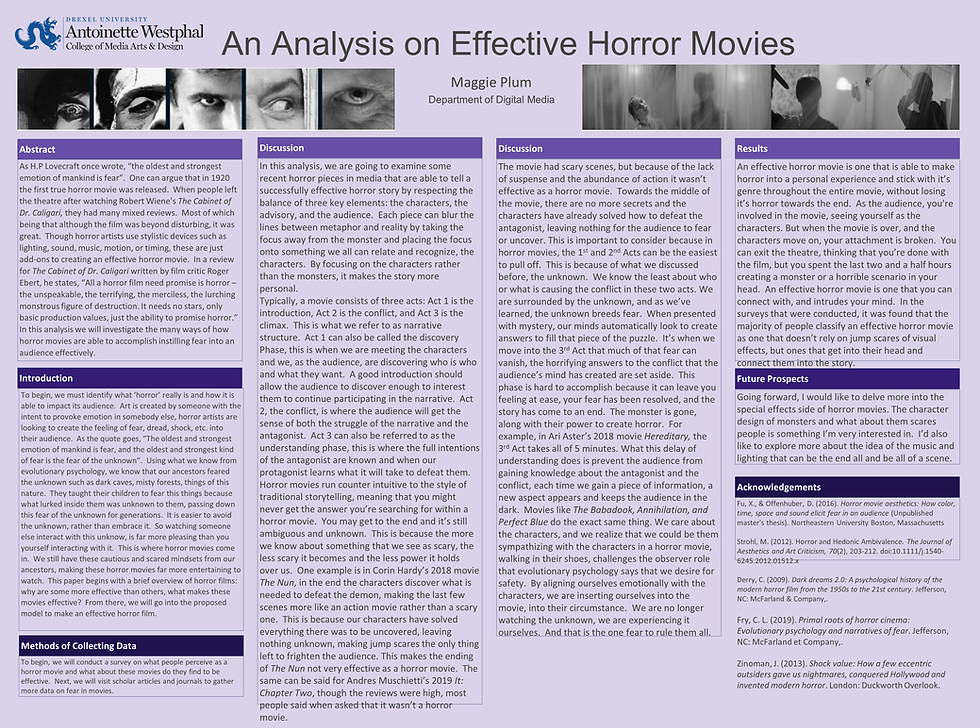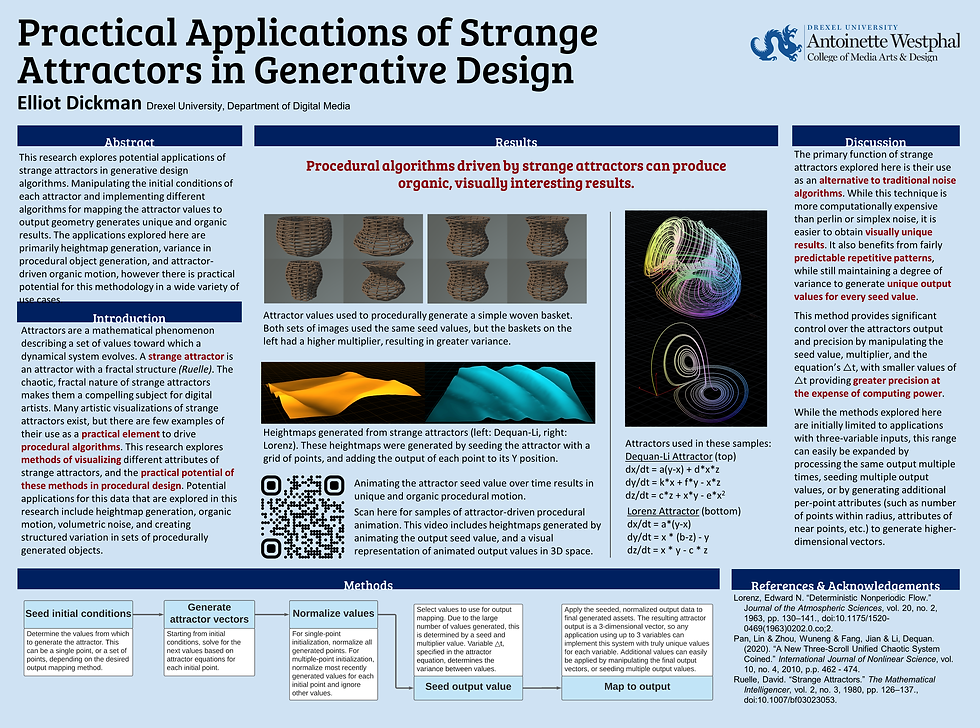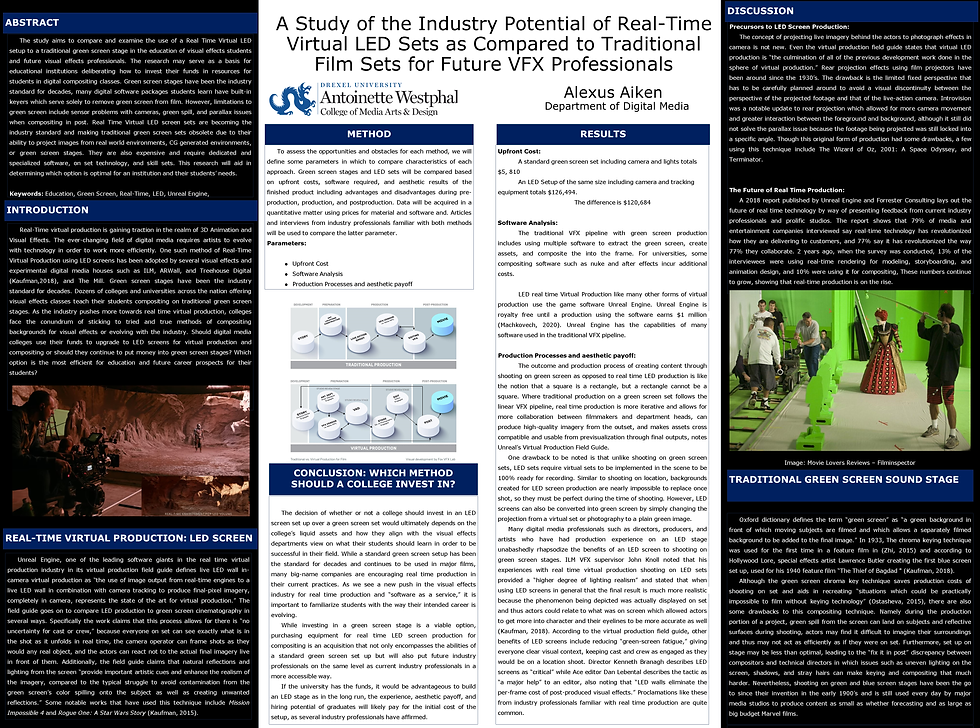Drexel Digital Media Undergraduate Research Lab
Summer, 2020
Mission
During the Summer term of 2020 a small group of undergraduate students of the Department of Digital Media participated in a newly formed research lab to learn basic research practice, evidence based inquiry, and research informed creative experimentation. The students were asked to identify topics of interest and propose a method of investigation supported by literature, methodology, and experiments appropriate to topics.
The goal was to work independently and to create an intellectual space to freely express ideas and questions related to the field and beyond, to foster cross-disciplinary and critical thinking.
Outcome
During the 10 week term with weekly meetings the group intensely worked on the topics to finally conclude the findings in a poster and in an oral presentation.
LGBT Representation in American Animated Entertainment
Elijah J. Bates
Are LGBT characters represented in media proportionately to the existence of LGBT people in the real world? The representation of LGBT characters in American media is on the rise - in 2013 4.4% of recurring characters in television were confirmed to be LGBT (glaad, 2020), while in 2020 it has reached 10.2% (glaad, 2020). But, where is the animation industry in the midst of this increase? Does the representation match the existence of real-life LGBT individuals?
Elijah J. Bates - Video Presentation
With Great Lighting Comes Great Responsibility: An Investigation of the How’s and Why’s Behind 3D Animated Lighting and the Power it Has Over its Viewers
Kate Euting
This study investigates the fundamental artistic and design considerations of using color and light in achieving a meaningful emotional impact in the viewer. While advanced digital applications allow an immense variety of choices, it still remains to be the artist’s job to decide what combination of choices will be applied for the intended result and experience. Though understanding and studying cross-disciplinary aspects, such as psychological, cultural and sociohistorical, it is evident that all connections need to be carefully evaluated when design decisions are made in regards to color and light. While the technology is almost limitless, it does not provide any solutions in this area, only tools. This work is an attempt to provoke a deeper inquiry and discourse among digital artists in order inspire new trends.
Kate Euting - Video Presentation


A Concept for Procedurally Generated Narrative based on User Engagement and its Practical Applications
Anjelikal Rogers
This study explores the implications and practical usability of computational technology trends that integrate artificial intelligence (Ai) in generating narratives. Computational creativity is still being considered as a sensitive topic in the traditional arts including literature, music, performance and visual arts. In the past, the evaluation of originality has always been perceived as the impact of human intellect and the product of a creative process that originates from humans. Today’s technological trends suggest that the intrusion of Ai in the guided creative process can have the tendency to the lead the output and contribute in a substantial way. Therefore studies that evaluate the practicality and usability are necessary in order to determine what level of originality is achieved.

Anjelikal Rogers - Video Presentation
An Analysis on Effective Horror Movie
Maggie Plum
As H.P Lovecraft once wrote, “the oldest and strongest emotion of mankind is fear”. One can argue that in 1920 the first true horror movie was released. When people left the theatre after watching Robert Wiene’s The Cabinet of Dr. Caligari, they had many mixed reviews. Most of which being that although the film was beyond disturbing, it was great. Though horror artists use stylistic devices such as lighting, sound, music, motion, or timing, these are just add-ons to creating an effective horror movie. In a review for The Cabinet of Dr. Caligari written by film critic Roger Ebert, he states, “All a horror film need promise is horror – the unspeakable, the terrifying, the merciless, the lurching monstrous figure of destruction. It needs no stars, only basic production values, just the ability to promise horror.” In this analysis we will investigate the many ways of how horror movies are able to accomplish instilling fear into an audience effectively.

Maggie Plum - Video Presentation
Practical Applications of Strange Attractors in Generative Design
Elliot Dickman
This research explores potential applications of strange attractors in generative design algorithms. Manipulating the initial conditions of each attractor and implementing different algorithms for mapping the attractor values to output geometry generates unique and organic results. The applications explored here are primarily heightmap generation, variance in procedural object generation, and attractor-driven organic motion, however there is practical potential for this methodology in a wide variety of use cases.

Elliot Dickman - Video Presentation
Study of the Industry Potential of Real-Time Virtual LED Sets as Compared to Traditional Film Sets
for Future VFX Professionals
Alexus Aiken
The study aims to compare and examine the use of a Real Time Virtual LED setup to a traditional green screen stage in the education of visual effects students and future visual effects professionals. The research may serve as a basis for educational institutions deliberating how to invest their funds in resources for students in digital compositing classes. Green screen stages have been the industry standard for decades, many digital software packages students learn have built-in keyers which serve solely to remove green screen from film. However, limitations to green screen include sensor problems with cameras, green spill, and parallax issues when compositing in post. Real Time Virtual LED screen sets are becoming the industry standard and making traditional green screen sets obsolete due to their ability to project images from real world environments, CG generated environments, or green screen stages. They are also expensive and require dedicated and specialized software, on set technology, and skill sets. This research will aid in determining which option is optimal for an institution and their students’ needs.
Keywords: Education, Green Screen, Real-Time, LED, Unreal Engine,

Alexus Aiken - Video Presentation
Animation’s Use of Technology to Copy the Style of Other Mediums
Joe Petrucci
There is no quality of animation as a medium which is more lauded than its ability to make the unreal seem real; to make fantasy a reality. As the medium has advanced over the decades we’ve seen innovations such as the replacement of cel animation with digital animation, or the advent of computer generated animation entirely. But in recent years the unreal has become more than real. we’ve reached a point where the parameters of these mediums are so well established and technology has progressed so far that artists have begun to blend these styles together.

Joe Petrucci - Video Presentation
Mapping Point Clouds to MIDI: An Exploration into Efficient Sound Design
Lucas Tomaselli
This research will present a look at the practicality and efficiency of procedural sound designing for animations and visual effects. Data from a 3D visual experience can be procedurally harnessed and reused to create a corresponding sonic experience. The applications discussed in this research are physics-based simulations with varied complexities and keyframe animations. While practical on a small scale, the limitations of applicable audio formats make this method of procedural sound design inefficient for large, complex applications.

Lucas Tomaselli - Video Presentation
The Dawn of Real-Time Rendering Solutions: An Exploration into the Integration of Real-Time Rendering Solutions in the Pipeline for Production
Stephen Abraham
Ever since the earliest renderers were developed in the late 1980’s, digital production pipelines have invested a lot of resources in speeding up the rendering aspect of the pipeline. Now with the advent of more powerful Graphical Units (GPU) with innate raytracing abilities, real-time rendering solutions have been massively researched and highlighted upon. The dominant explanation for this trend is with the advent of game engines employing a similar rendering philosophy from the earliest days of video game inception. Previous research has shown especially with the revolution of the Unreal Engines of the significant speed increase in real time rendering and why more and more video games are shifting towards the employment of technology based on the Unreal Engine system of real time rendering. With the introduction of Blender’s own real time renderer “EEVEE”, the trend shows that almost every major production studio having an interest in researching more real time rendering options due to the cost reduction it has on the pipeline budget. We setup specific scene renders for three specific renderers- “EEVEE”, “Cycles” and “Arnold” following which we compare the respective times and aesthetic comparisons based on the inclusion of Sub-Surface Scattering (SSS) and Light Proxies (LP). The results show that the real time rendering of EEVEE is significantly faster than the renders of Cycles and ARNOLD on a generic scene level. When we introduce more complicated features such as the SSS and LP, it appears that visually EEVEE fails to calculate the subtle pixel depth for the ray calculation, since it is essentially a rapid rasterization algorithm and hence visually looks visibly different. The findings indicate that while real time rendering shows extreme speeds for render calculations, it still does not fully employ the Monte Carlo ray tracing algorithm to accurately define photorealism in its renders.

Stephen Abraham - Video Presentation
